Text
Update, been away and got the Cyclopedia
As you may have noticed, I've been away for a bit (lots have happened in my life, moving around and getting teeth removed and so on...). I hope to get some more posts on here, BUT a few things to note.
I've just got my hands on the DnD B/X Cyclopedia pdf, so that'll allow me to update a few posts as well as provide more accurate info for future posts.
I appreciate your patience and I hope to make more posts here soon.
0 notes
Text
Today's DnD Creature, The Chimera


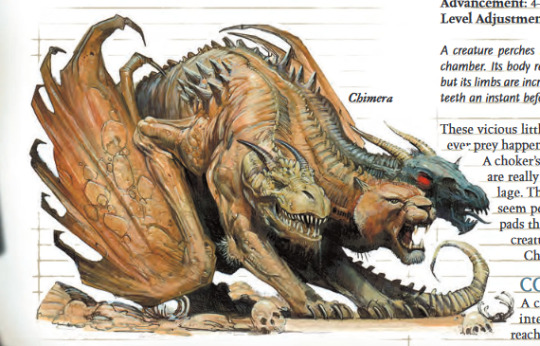
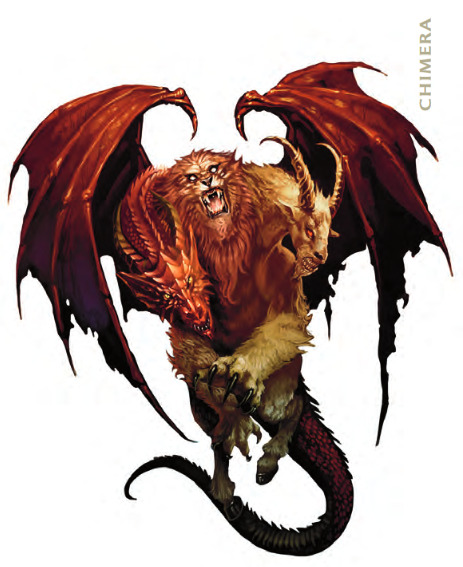

Editions appeared in: Chainmail, ODnD, DnD B/X, ADnD, ADnD 2e, DnD 3.5e, DnD 4e, & DnD 5e
Consistent Elements:
The Chimera is a winged amalgamation that infuses a lion, a goat, and a dragon into a single body with three heads.
Notable Differences:
From birds of a feather to bitter enemies. Originally, the Chimera in Chainmail was clumped in with other hybrid monsters, such as griffons, hippogriffs, and wyverns with few details. In DnD 5e, these creatures, along with dragons, manticores, and perytons, are considered rivals to each other.
Limited Draconic Speech. The chimera gains the limited ability to speak the language of red dragons in ADnD, though how limited this speech is remains unclear. In ADnD 2e, it is elaborated that chimeras are more likely to converse with more powerful creatures than itself, a trend that continues in DnD 3.5e where it speaks draconic rather than just the language of red dragons, though it may be likely to be more familiar with the speech of whichever dragon head it has than with others. In DnD 4e, it seems to know both common and draconic. In DnD 5e, the chimera is reduced to knowing draconic but being unable to speak it.
Chaotic Behavior. Not much is explained about the chimera’s behavioral patterns until ADnD 2e, where it can maintain a somewhat omnivorous diet due to its herbivore goat and carnivore lion and dragon heads. Though it’s made clear that the carnivores would only be satisfied with flesh. The lion and dragon heads also clash with one desiring to be in a pride and the other remaining in solitude in a cave respectively. No details of the chaotic nature is mentioned again until DnD 5e, where most of the chaos spawns from how each head is equally hostile, making it more of a threat to other creatures rather than be in conflict with itself.
Dark and no longer mysterious origins. The origins of how the chimera came to be remained unanswered for most editions, with ADnD 2e even stating it may be best to leave such things unanswered which implies a very dark truth. In DnD 5e however, the first chimeras were created by Demogorgon who took several creatures he was unimpressed with and infused them into the hybrid monsters we know, though how they don't know abyssal or aren't considered demons as a result is beyond me.
Moments of Ambushing. In ADnD 2e, DnD 3.5e, and DnD 5e, the chimera is noted to surprise its prey with swooping attacks from above. They mention its dragon head could use its breath attack as an alternative to biting. In ADnD 2e and DnD 3.5e, chimeras strike in concert if more than one chimera participates in the hunt. In DnD 5e, the chimera sprays the ground in flames as it swoops down before landing to attack.
Unfortunately for you… you are MANELESS. In most editions, the chimera was described or at least visually depicted with a mane for its lion head. Only in DnD 3.5e did the chimera lose its mane and was specifically described to be maneless. Not an important detail, just thought it was kinda funny.
Variant Dragon Heads. Throughout most editions, the chimera’s dragon head breathes fire. In DnD 3.5e, the game master is presented with a few options to swap the dragon head with any they wish, changing its breath weapon to the dragon head most appropriate with it, such as blue for lightning, green for poison, black for acid, and white for cold. In DnD 4e, the chimera has the standard stats for a fire-breathing red dragon one, but there is a note saying other variants exists. No details of these variants are mentioned in DnD 5e.
Unusual Mounts. In DnD 3.5e, there are unusual notes for the carrying capacity of a chimera, not dissimilar to notes given to mounts. In DnD 4e, it is explicitly stated that chimeras can be trained as guards or mounts. No details are given in other editions.
Expanded Territories. In ADnD 2e, chimeras were said to have territories of up to 20 square miles(which would be about ~5 miles wide). In DnD 5e, it was rephrased to have territories of up to 10 miles wide(which is about ~78 square miles).
Origins: In Greek Mythology, the Chimera was a unique creature that terrorized the countryside by eating cattle and spreading flames from its goat head. Bellerophon was able to slay it by riding Pegasus into the sky and pelting with arrows, which seems to imply it never had wings originally? [Wikipedia Article]
22 notes
·
View notes
Text
Update
No monster for today. Just taking some time to enjoy the Christmas weekend.
Merry Christmas and Happy Holidays for those who celebrate. And for those who don't, hope you have a good relaxing weekend.
Stay safe and warm, and I'll have a new monster entry soon.
0 notes
Text
Today's DnD Creature, The Treant





Editions appeared in: Chainmail, ODnD, DnD B/X, ADnD, ADnD 2e, DnD 3.5e, DnD 4e, & DnD 5e
Consistent Elements:
This tall and tree-like being is capable of animating one or more trees nearby to aid it in combat. The animated trees, much like the treant itself, have a debilitating weakness to fire.
Notable Differences:
Animate Trees. From Chainmail and onward, the number of trees animated by the treant has consistently been 1 to 2 trees at a given time. Though in DnD 4e, the treant had the ability to animate up to 3 trees in every group of 10. This number returned to 1 or 2 in DnD 5e.
Abhorrence to fire. From Chainmail to ADnD 2e, the use of fire based weapons made it easier to hit and damage treants and the trees they animated. From DnD 3.5e and onward, this became a vulnerability to fire damage, which simply dealt extra damage. Only in DnD 4e would the Treant catch continuous fire upon failing a saving throw after taking fire damage.
Appearance of a Tree. While the treant’s tree-like appearance was always implied from the very beginning, their appearance would become a passive camouflage (especially when motionless) starting in ADnD 2e and continuing onward to DnD 5e. Only in ADnD 2e and DnD 3.5e is it stated that a treant’s leaves even change color with the seasons, but do not fall out like normal trees.
Siege Beast. The treant’s ability to lay siege began in ADnD where it dealt extra damage to structures. It changed in DnD 3.5, where they dealt double damage to objects and structures. A trait that was dropped in DnD 4e and reinstated in DnD 5e.
Lost language of the tree-folk. From ADnD 2e to DnD 3.5, the treants had their own language and knew the languages of various other creatures, or at least knew enough to effectively communicate “Stay away from my trees!” to non-treants. In DnD 4e, the treants lost most of these languages and knew only elvish. In DnD 5e, they regained some additional languages (Common, Sylvan, and Druidic) but their own unique language was lost.
Intolerance to axes and similar evils. The treant’s disdain for evil beings, as well as for wanton destruction in general, began in ADnD. In ADnD 2e, they are stated to have a prejudice against orcs and goblins and being suspicious against those who carry axes. In DnD 3.5e, this animosity seems to be shifted to any creature that despoils a treant’s forest. In DnD 4e, this animosity becomes more flexible as a treant may either attack trespassers or just those who harbor ill will to their woods with axes and torches, though they are usually friendly to those who respect the woods. In DnD 5e, treants are unlikely to attack woodsmen that don’t take more from the bounty of the forest than what they need, instead focusing their ire against those who are careless with(or actively use) fire, poisons, or other things that bring destruction to the forests.
Inconsistent Lifecycles. In ADnD 2e, treants were a plant-like species that reproduced via offshoot stalks. This detail was omitted in later editions and replaced entirely in DnD 5e where in order to create new treants, druidic magic must be placed upon special trees to awaken them as new treants. This magic can be used by treants and powerful druids alike.
Origins: Likely a corruption of Ents from JRR Tolkien's works. This name change was probably enforced by TSR during the game's early development after reviving a cease-and-desist order from Elan Merchandising. [Wikipedia Article on Ents] On another note, check out these Mythical Trees!
10 notes
·
View notes
Text
Update
Apologies for the Dragon Turtle post. I noticed quite a few misspellings and formating issues after posting, things that should have been fixed in drafting beforehand.
It's not something I've been called out on, but I have fixed those mistakes. I'll try my best to be a bit more patient before queueing up these posts. Though that does mean it'll take some more time in between them.
All feedback is appreciated, thank you for being patient with me!
0 notes
Text
Today's DnD Creature, The Dragon Turtle



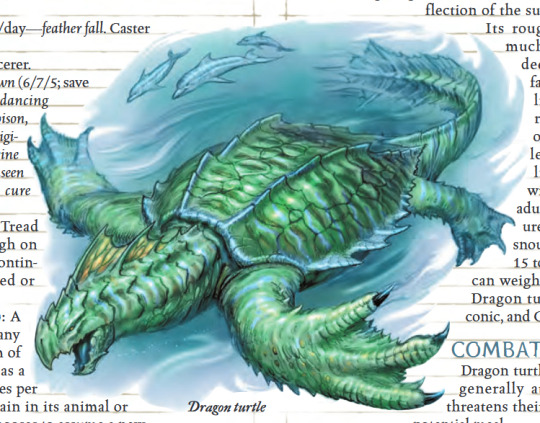

Editions appeared in: ODnD(Book III), DnD B/X, ADnD, ADnD 2e, DnD 3.5e, & DnD 5e
Consistent Elements:
As the name suggests, this creature is a dragon-like (and often dragon-sized) turtle. It is often noted for its green shell with silver highlights that mimic the traits of the bodies of water it inhabits, both on the surface and deep in the waters.
Notable Differences:
Cases of Mistaken Identity. In DnD B/X, A dragon turtle could be easily mistaken as a small island to unsuspecting sailors. From ADnD to DnD 5e, it is often mistaken for the reflection of the sun or the moon in the sky as it rises to the surface, a facade that quickly ends when it attacks and sinks ships that pass through its territory. While a last resort in combat, it is also known for its devastating steam breath weapon.
Lost Golden Highlights. While a minor detail, the dragon turtle was noted to have golden highlights upon its green/gold head, green/gold neck, and light green tail in ADnD. In ADnD 2e, the legs also held a similar golden highlight which was kept in DnD 3.5e. There seems to be no mention of these highlights in DnD 5e. The detail isn't super important, I just thought it was curious.
Capsizer. From ADnD to DnD 3.5e, the dragon turtle was nortorious for its ability to capesize ships, granting a percentage chance of this occurring if it slammed its shell against them. This feature is omitted in DnD 5e.
Unique Language. From ADnD to ADnD 2e, the dragon turtle was known to speak its own language. As of DnD 3.5e, this language was removed with Draconic, Common, and Aquan being its known languages. In DnD 5e, it only knows Draconic and Aquan.
Treasures in Sunken Lairs. In ADnD 2e and DnD 5e, the dragon turtle is noted to not only attack and sink passing ships but also collect the valuable treasures within to bring back to its lair deep in a sea cave. In DnD 5e Strangely enough, it is specified that the dragon turtle actively seeks out gold coins and precious items to swallow up, transport, and spit out into its lair.
Territorial Tributes. In ADnD 2e and DnD 5e, various sailors offer tributes to dragon turtles to assure safe passage through its territories. An unusual note is that while dragon turtles compete with various intelligent sea creatures in ADnD 2e, they do make alliances with Sahuagin and aid them in raids in DnD 5e.
Origins: The original dragon turtles come from Chinese folklore, and like most Asian dragons, they are benevolent and often symbols of good luck. [What does the Dragon Turtle Symbolize, Wikipedia Article]. Which is funny because before reading the entries and looking up sources, I figured it was a reference to the living island fish from Sinbad the Sailor [Wikipedia]. [Also check out this article on what Turtles symbolize in various cultures].
17 notes
·
View notes
Text
Today's DnD Creature, The Griffon

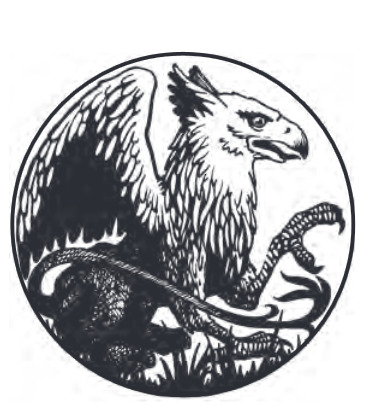




Editions appeared in: Chainmail(as an alternative to Rocs and Wyverns), ODnD, DnD B/X, ADnD, ADnD 2e, DnD 3.5e, DnD 4e, & DnD 5e
Consistent Elements:
This creature is a composite hybrid between eagle and lion. They have a fondness for horse flesh and are prized as loyal but difficult to tame mounts.
Notable Differences:
Fond of Horsemeat. The Griffon’s preference for horse flesh above other meats begins in ODnD. From then to ADnD, the Griffon would attack horses as soon as they were visible on a gameboard. In ADnD 2e, this distance expanded to as far as 2 miles and they would attack their prey even if there was a rider present. This detail was omitted in DnD 4e as they were grouped with Hippogriffs and reestablished again in DnD 5e when they became their own beasts again.
Birds of a Feather. In chainmail, the Griffon was grouped with Rocs, Wyverns, Hippogriffs and Chimeras. From ODnD to DnD 3.5e, Griffons were established as their own creature, much like the others mentioned. In DnD 4e, they were regrouped with hippogriffs with no mention of past animosities (even their desire for horseflesh was ommited). These two became their own beasts once again in DnD 5e.
Rocky Territories. Starting in ADnD, Griffons would settle in the cliffs and rocky habitats to build their nests. In ADnD 2e, Griffons would hunt as prides within the planes and forests within 20 miles of their lairs in the mountains. These details would be absent in DnD 3.5e and DnD 4e but would return again in DnD 5e.
Prized Sky Mounts. Despite being the hybrid form of two wild animals, the use of Griffons as mounts goes as far back as ODnD and persists to the current edition. The prices for gathering griffon eggs to raise as mounts are mentioned in ADnD to DnD 3.5e.
Origins: While griffons were a common symbol used in medieval coat-of-arms and being mentioned frequently in ancient Greek documentations, the earliest deception of an eagle-headed lion can be traced back to ancient Egypt and have since been used as a motif across various Mediterranean cultures. [Wikipedia Article] In many ways, the griffon in folklore and mythology seems to be as flexible in its use as the dragon is (if not as iconic as it is today).
11 notes
·
View notes
Text
Today's DnD Creature, The Medusa

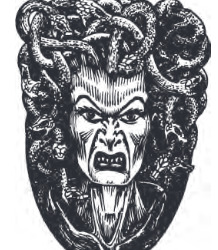
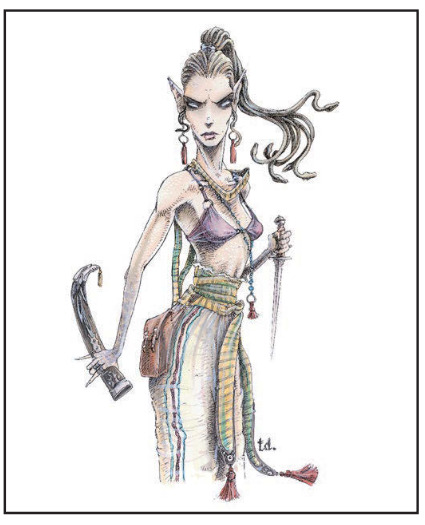

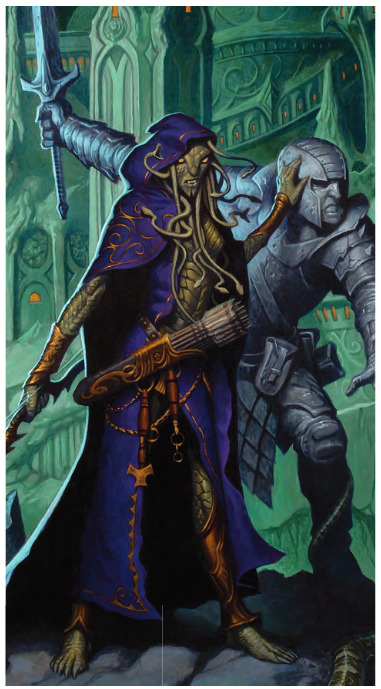

Editions appeared in: ODnD, DnD B/X, ADnD, ADnD 2e, DnD 3.5e, DnD 4e, & DnD 5e
Consistent Elements:
A medusa is a humanoid creature with poisonous snakes replacing the hair on its head and a gaze that can petrify creatures into stone.
Notable Differences:
Various Serpent Forms. While most versions are consistent, there are a few added details to the Medusa’s serpentine nature. In ODnD and ADnD 2e, some medusas will have a serpent tail in place of a lower body, sometimes making the monster 10 to 20 feet in length. From ADnD 2e to DnD 4e, some medusas are noted to have scales covering the whole body rather than just the asps in their hair. The strangest form comes from DnD B/X, when a medusa is found on the elemental plane of earth, as there they are described as alien beings with several 10ft long tentacles and 1ft long eye stalks spawning from a round and lumpy body.
Victim of its own gaze. From ADnD and beyond, the medusa could become a victim to its own petrifying gaze. In ADnD 2e, there is a somewhat contradictory note that while they can petrify themselves, multiple medusas cannot petrify each other.
Adapting when Gaze and Poison Fails. From ADnD 2e and onward, the medusa gains the use of swords and bows to compensate when either a target averts their gaze or is resistant to the snake hair’s poison.
Disguised from a distance. From ADnD to DnD 3.5e, there have been notes on how a medusa's form appears as a normal human from a distance greater than 30 feet. In DnD 3.5e, the medusa could even keep itself disguised at closer distances if it is able to.
Otherworldly Sight. From ADnD to ADnD 2e, the medusa was able to see into the astral and ethereal plane, granting no safety from its gaze even beyond the material plane. This arguably overpowered ability seems to be omitted in later editions.
Strength of Petrification. From ODnD to DnD 3.5e, if a creature fails to avert their gaze from the medusa’s and fails a saving throw against the effects, they permanently turn to stone. Only in DnD 4e and onward would one get at least a second chance before this effect takes place, though one could instantly turn to stone with a particularly bad saving throw in DnD 5e. For a while, there was no notes on curing it until DnD 4e, where the blood of a slain medusa can cure its petrification. In DnD 5e, a Greater Restoration spell can cure the petrification.
Sexual Dimorphism every other edition. There’s only two versions of male medusa counterparts found in ADnD 2e and DnD 4e. Both of them are described to be without snake hair and the petrifying gaze. In ADnD 2e, The Medusae Maedar was noted to be an extremely rare male counterpart that was immune to the petrification and poisons of its female counterpart. While lacking the gaze, one out of 3 of the Maedar’s melee strikes could afflict petrification. The Maedar was also noted to have various abilities of manipulating inorganic material such as phasing through stone, turning stone to flesh for consumption, and animating objects while its spirit was trapped in a gemstone. In DnD 4e, The male medusas were noted to be as scaly despite lacking the snake hair. It was also noted to have its own unique gaze that was both poisonous and disorienting.
Poisonous Blood. In ADnD 2e, a greater medusa is said to have blood just as poisonous as the bites of its serpent hair, requiring a similar saving throw when one touches the blood of a slain greater medusa. In DnD 4e oddly enough, the blood of a slain medusa can cure its petrification.
Origins: In Greek Mythology, Medusa was the name of a beautiful woman who was transformed into a hideous creature by the gods. In some versions of the myth, Medusa had two immortal sisters who also had monstrous forms. [Mythopedia, greekmythology.com, Wikipedia article on Medusa] The monsters these sisters became were known as Gorgons, but the name was already used in DnD by another creature.
#dnd#dungeons and dragons#medusa#gorgon#monstrosities#humanoid#monstrous humanoid#greek mythology#planar monster#monster
10 notes
·
View notes
Text
Today's DnD Creature, The Wraith

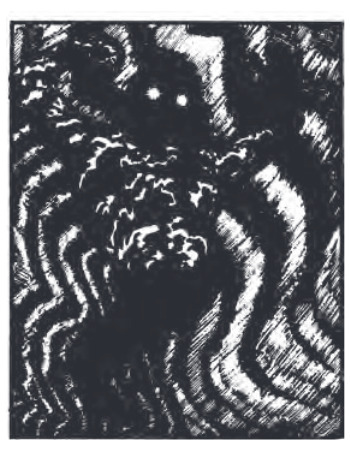

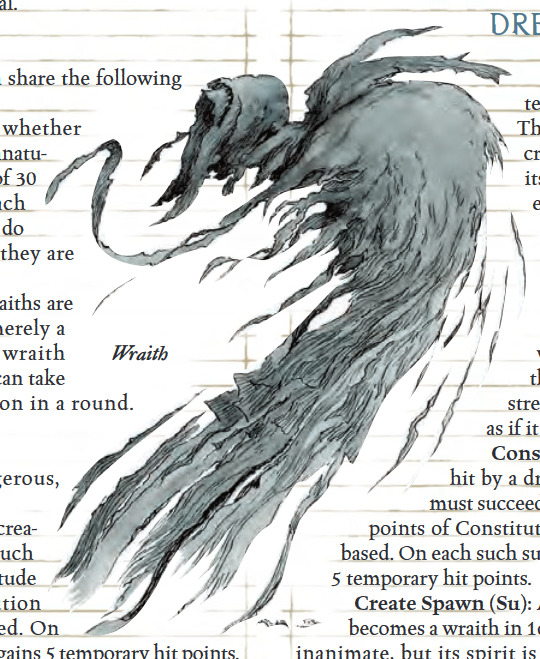


Editions appeared in: Chainmail, ODnD, DnD B/X, ADnD, ADnD 2e, DnD 3.5e, DnD 4e, & DnD 5e
Consistent Elements:
Wraiths are spectral beings that can fly and phase through objects. They have a notorious touch that has various effects depending on the edition. They also are impervious to most weapons with the exception of magical weapons, likely due to being ghostly beings.
While starting in Chainmail, the Wraith's concept would be expanded upon in ADnD, and fully fleshed out in ADnD 2e.
Notable Differences:
The Deadly Touch. The Wraith's horrid touch has seen many revisions. In Chainmail and ODnD, the touch simply caused paralysis. In ADnD, the touch dealt damage and would raise a slain adversary as a weaker wraith under the slayer's control. In ADnD 2e, the touch would permanently drain experience in addition to dealing damage and raising lesser wraith servants from slain adversaries. In DnD 3.5 the experience drain is replaced with a Constitution drain and the created wraiths we're not weakened. In DnD 4e, the Constitution drain is removed and created wraiths were noted to be "free-willed". And in DnD 5e, the touch would drain a character's hit point maximum upon a failed constitution save, and it would no longer create wraiths but specters under the slayer's control instead. For some reason, the Wraith would be limited to only 7 specter servants at a time.
A Mostly Untouchable Form. From Chainmail and ODnD to ADnD 2e, silvered and magical weapons were noted to be the only tools that could damage wraiths. Special details in ADnD 2e would suggest that ordinary weapons would just phase through them and magical weapons would cause their form to "boil". These details seem to be dropped in DnD 3.5e and DnD 4e. In DnD 5e, Wraiths can be half damaged by normal weapons and fully damaged by silvered or magical ones.
Special Immunities and Weaknesses. Other immunities and weaknesses would be mentioned in ADnD such as poisons, paralysis, and spells that afflict hold, sleep, cold, or charm. Holy water is stated to harm them and a Raise Dead spell can destroy them. In ADnD 2e, death spells would be added to the Wraiths immunities. These details would be omitted from DnD 3.5e and onward.
Weakness in Sunlight. The Wraith’s aversion to sunlight would be first mentioned in ADnD 2e where they are said to be unable to fight in direct sunlight unless pressured to. In DnD 3.5e, the wraith’s actions are limited in sunlight, encouraging it to move out of it. In DnD 4e, there is only mention of a vulnerability to radiant damage. In DnD 5e, Wraith loses the radiant damage vulnerability and it’s vision becomes affected by sunlight, imposing disadvantage on attacks and perception checks reliant on sight.
Passive Regeneration Every other Edition. The Wraith gains a regeneration trait in ADnD 2e where it can recover 1 hit point per day, a unique trait for an undead I suppose. The regeneration seems to be dropped in DnD 3.5e and the wraith regains a quicker version of this trait in DnD 4e where it recovers 5 per round as long as it takes no radiant damage. The trait is dropped again in DnD 5e.
A frightening presence to animals. In ADnD 2e, the Wraith gains the ability to strike fear into animals that can sense it, forcing them to keep their distance. This trait is emphasized in DnD 3.5e, omitted in DnD 4e, and mentioned only in passing in DnD 5e.
Origins: While Popularized by JRR Tolkin's Ring Wraiths, the creature actually holds its roots in Scottish myth as a sort of ghostly doppelganger or spirit double, and the first use of the word Wraith dates back to 1513 [Wraith Definition from Merriam Webster, Mythical Creatures Guide].
14 notes
·
View notes
Text
Today's DnD Creature, The Pegasus
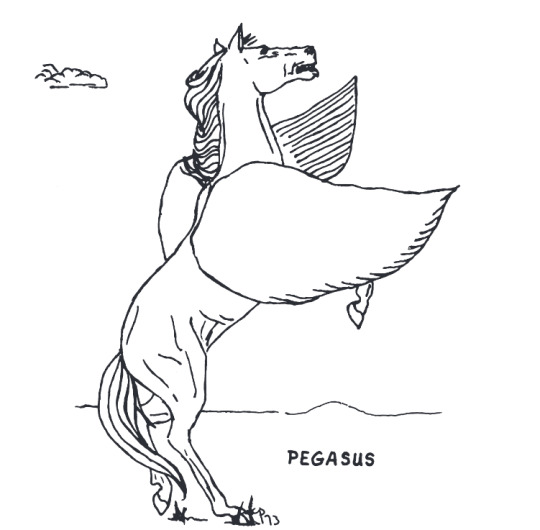




Editions appeared in: ODnD, DnD B/X, ADnD, ADnD 2e, DnD 3.5e, & DnD 5e
Consistent Elements:
The Pegasus is a wild and shy horse with wings that grant it the ability of flight. They are considered prized mounts but are notoriously difficult to tame as mounts.
Notable Differences:
Mounts for Good (and patient) Beings. While they could only be mounted by "Lawful characters" in ODnD, They have since been specified to be better suited as mounts for "Good" creatures from ADnD and onward. Taming is notoriously difficult but once succeeded, the Pegasus becomes a life-long companion to the rider.
Pegasi Nests. From ADnD and onward, pegasi are stated to build their own nests. Pegasi mate for life and both partners will protect their nests. They were stated to keep 1 to 2 eggs in their nest at a given time until in DnD 5e where they give live births instead. There were also notes from ADnD to DnD 3.5 about how valuable these eggs, as well as young pegasi, were in the market.
Powerful Bite and Hooves. From ADnD to DnD 3.5, the pegasus is noted to fight with both its hooves and its bite. In DnD 5e, it only uses its hooves to fight.
Intelligent Horses. From ADnD and onward, the pegasus is noted for its intelligence, in some cases being able to speak its own language and that of other horses as stated in ADnD 2e. In most cases, it can simply understand the languages spoken by others even if it cant reply in turn.
Sexual Dimorphism and Color Variants. In ADnD and ADnD 2e, male pegasi are stated to be equivalent to a medium warhorse while females are equivalent to light warhorses in terms of carrying capacity. Also while pegasi are often depected as white horses, there are said to be brown and black variants in ADnD 2e and DnD 3.5e with no change to their typical Chaotic Good alignment. Such details are omitted in later editions.
Origins: The Pegasus comes from Greek Mythology. [Wikipedia Page on Pegasus, From greekmythology.com] The Greater Pegasus Entry in ADnD 2e actually holds details that closely resembles one version of the Greek myth where the original Pegasus spawns from the severed neck of the original Medusa.
10 notes
·
View notes
Note
I love this concept. Looking forward both to more D&D classics like the beholder and the terrasque, and to more esoteric stuff that devs felt free to completely re-imagine multiple times over different editions, like the shadar-kai.
Thank you! I do find the development and history of these creatures fascinating and I'm glad you feel the same.
I'll be starting with creatures shared in Chainmail and ODnD before I get to those classic(and esoteric) ones, but I'm not opposed to looking into those suggestions at some point. 🤔
1 note
·
View note
Text
Today's DnD Creature, The Gnoll






Editions appeared in: ODnD, DnD B/X, ADnD, ADnD 2e, DnD 3.5e, DnD 4e, & DnD 5e
Consistent Elements:
Although Iconic as a hybrid human/hyena marauder, the history of the Gnoll's development over the years seems to hold procedural changes over the decades. In fact, from ADnD onward, the Gnoll progresses from a simple antagonist that values strength and cooperation and detests menial labor, to a sadistic, hunger-driven, demon-spawned scourge that would sooner bite your face off before any shared words could even be considered.
In a way, the true consistent element for Gnolls is a steady decline from what they used to be. I say this only as an observation rather than a critique, as such a decline can still be interesting from a storytelling standpoint if used effectively.
Notable Differences:
Defined Appearance. While appearing in ODnD, Gnolls don’t get much of a description until DnD B/X and ADnD establishes them as Hyena-like humanoids that operate in bands of loose organizations.
Gnoll Creation. In the begining, Gnolls of ODnD were just labled as a cross between Gnomes and Trolls. Not much is stated about the origins of Gnolls until DnD B/X where gnolls are said to be the magical infusion of Gnomes and Trolls. This detail is omitted in later editions, including ADnD where no clear origin is stated. In DnD 5e, however, gnolls are stated to spawn when hyenas cursed by Yeenoghu overfeed on carrion found in battlefields or places of mass carnage, from which the hyena's guts burst and a gnoll spawns from the bile.
From Slavers to Cannibals. While noted in ADnD to having prisoners stored for slave labor or food, the sadism and savagery of Gnolls begin to be emphasized in ADnD 2e with how they find preference in eating intelligent creatures over animals due to how they “scream better”. In fact, it’s first mentioned in ADnD 2e of how Gnolls may prioritize their hunger over their allegiances with orcs, hobgoblins, bugbears, ogres, and trolls if their strength overpowers their partners’. This trend for hunger and sadism seems to get worse with each edition.
Rising Demon Allegiance. The Gnolls’ worship of Yeenoghu is mentioned under said demon’s monster entry in ADnD, but wouldn't become part of the Gnoll’s entry until DnD 3.5e where he’s mentioned as a being they “serve and revere”. This trend of demon worship continues onto DnD 4e.
Lost Playable Option. Despite being a more sadistic antagonist, DnD 3.5e does make note of Gnolls as a playable character option. Such an option hasn’t appeared in official WotC books since.
Too hungry to be lazy anymore. From ADnD to DnD 4e, Gnolls are stated to be creatures that detest manual labor and will force captive prisoners into slave labor to perform tasks they would rather not do. Such a detail seems to be omitted for the most part in DnD 5e. While such a change is likely due to a change of political climate, I also think this suggests that Gnolls are at a point where they can't even manage their hunger to keep slaves anymore.
Decline in Tactics. From ADnD 2e to DnD 4e, Gnolls are said to prefer ambushing and flanking adversaries over laying out traps. Even this tactical strategy is omitted from DnD 5e, as gnolls would likely just rush in and strike quickly, relying on overwhelming force and taking out as many opponents as possible within quick succession.
Origins: This creature is a Gygax original, initially a cross between gnome and troll inspired by the works of Lord Dunsany [from the man himself, ]. Though how they became hyena/human hybrids in later versions remains a mystery.
36 notes
·
View notes
Text
Today's DnD Creature, The Purple Worm



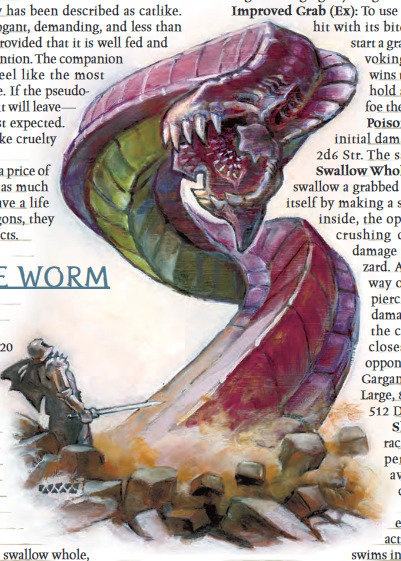


Editions appeared in: ODnD, DnD B/X, ADnD, ADnD 2e, DnD 3.5e, DnD 4e, & DnD 5e
Consistent Elements:
This creature is a massive worm of purple hue with a mouth wide enough to swallow an unlucky adventurer whole. It can even swallow creatures as large as horses or ogres. It's known for burrowing in the earth, swallowing various organic materials indiscriminately.
Notable Differences:
The Great Maw. The original swallowing attack from ODnD Book 2: Monsters and Treasures was simply deadly with no clear way for a character to escape from unless it is quickly slain by other party members. In DnD B/X (as of the Cyclopedia), a swallowed victim took continuous damage each round, where such details for damage are absent in ADnD and ADnD 2e, it is safely assumed the victim is NOT having a good time while being digested. Options for damaging the beast from the inside were only made with clearer details in ADnD and onward. Until DnD 3.5e, a character was expected to die from the swallow after 6 rounds and be considered fully digested and unable to be resurrected after 12 rounds. Such details of this horrid digestion are absent from DnD 3.5e and onward. However, the character’s ability to escape from the beast’s gullet would be strangely removed due to the restraining conditions employed from DnD 4e and onward, once again returning to the ODnD’s team dependency for freedom, though without the notes for horrid digestion.
Vestigial Stinger. While it’s had a poisonous stinger from ODnD, details about it’s stinger would only be elaborated upon starting from the ADnD Monster Manual, which would instantly kill a character should they fail a saving throw against it. This lethality would be reduced to just damage in DnD 3.5. It would lose the stinger in DnD 4e and regain it in DnD 5e. It’s important to note that the worm’s bite is meant to be considered far worse than its sting, so perhaps this poisonous attack shouldn’t be worried about too much.
Wasting Treasures. From ADnD and onward, these worms would be said to expel “indigestible materials” such as gemstones and metals, implying these are treasures that adventures can expect to loot from these beasts. DnD 3.5 specifies that most of these materials would be acid resistant and may even be found deep in the beast’s gullet.
Solitary Worms. The worm’s solitary nature would be emphasized in various details from ADnD 2e and onward. However, ADnD 2e would have the clearest details about separating from their siblings after birth and only seeking others of their kind exclusively for mating.
Tremor Sense. The worms ability to sense tremors would be specified from ADnD and onward.
Origins: Likely A Toy from an old Prehistoric Creatures/Ultraman Knockoff Set [where do dnd monsters come from, Owlbears, Rust Monsters and Bulettes, Oh My!]. And while unconfirmed, the worm also holds some resemblance to several fantastical worms from the Mongolian Death Worm, the Sand Worms from the Dune books, and the Dholes/Bholes from the Cthulhu Mythos.
9 notes
·
View notes